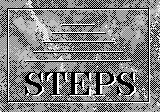
 | STatistical Education
through
|
 |
Getting Help |
|
The funding for the STEPS project came to an end at the close of 1995. The STEPS material together with instructions and help files is maintained by the CTI Centre for Statistics on a best endeavours basis. Allow yourself plenty or time to get problems ironed out before you require the STEPS material in your teaching. Usually installation will be straightforward, but occasionally there are problems which take a little while to fix. Please help us to help you by using the following three point plan:
|
 |
Frequently Asked Questions |
|
| Can the STEPS modules be installed on Windows 95 machines? |  |
Although the STEPS material (and particularly its installer) were designed for use under Windows 3.1/3.11, they do work under Windows 95. There is however one problem on some Windows 95 machines and that is that the installer does not create icons for each module in the STEPS Group folder. This task must then be undertaken manually as described in the later question "The installer has not created icons for the modules that I have installed. How do I create them?"
| Does the STEPS material run on a network or does it have to be installed on stand-alone machines? |  |
The STEPS installation procedure allows you to install the material on any logical drive provided by Novell, Windows NT, etc. The default is to install in the directory 'C:\STEPS' but 'P:\SOFTWARE\CBL\STEPS' is just as good.
In the STEPS.CFG file, you can specify three filestore locations:
| Location | Purpose | |
| Working | Allows STEPS Apps to communicate with each other through temporary files. | |
| Student | Some STEPS Apps allow students to take work away, it will be saved here. | |
| Misc | Miscellaneous information (e.g. a log of progress) may be written here. |
You may specify any location for these, on any networked drive, but they must all be writeable.
Occasionally, there are difficulties on a network with some of the older modules (which use an earlier version of toolbook). Should any problems arise, you should be able to rectify them by fully specifying the pathname in the Properties of the module. For full details about how to do this, see the answer to the question "When the STEPS Base is installed, it wants to alter my autoexec.bat file. Is this necessary or is there a way to avoid it?"
| Where is all the STEPS material for the Apple Macintosh? I can find only one Module, "Bullying in Schools", on the STEPS Web site. |   |
Although it was the intention to make the majority of the STEPS materials available for both PC and Mac, a survey undertaken by the STEPS consortium revealed very little interest in STEPS material for the Mac. Most of the effort was concentrated on the PC and there is only one module plus the statistical Glossary available for the Mac.
 Installation
Installation| I have downloaded some STEPS modules, how do I get them to work on my machine? |  |
If you read the installation instructions (Windows or Mac) provided on the STEPS Web site you should have no difficulty downloading and installing STEPS modules on your machine. The frequently asked questions provided in this list should help with any specific problems which you may have.
| What do I do if I don't want to make a set of floppy disks to install the STEPS material from, as outlined in the Windows installation instructions? |  |
The first thing that you do is to download a Zip archive (as a .exe file) of either the Base or a module. You then unzip the archive by running the .exe file.
The installation instructions then tell you to copy files onto floppy disks. If you are installing on the machine you are using for the download, this is not strictly necessary and you may run the setup.exe file directly from your hard disk. In that case you run setup as c:\steptemp\setup.exe rather than a:\setup.exe as indicated in the instructions.
Important: Remember to delete the files from the temporary directory steptemp before trying to download and install another module.
| I have downloaded a .exe file from the STEPS server, but when I try to run it it does not work. What is going wrong? |  |
The most common cause of this is a failure in the downloading process. Unless you are watching very carefully, you are unlikely to see any failure messages when your Web browser downloads a STEPS archive. To help you check that downloading has been completed satisfactorily, the file size is given alongside each file in the download lists. You should check that the downloaded file size is exactly the same as that given on the Web page from which you downloaded the file. If they do not match, you will have to download the file again. A download failure is rarely the result of a problem at our end, but is usually a network problem between you and us; there is nothing that can be done except to be patient and try again at a different time (the morning - UK time - is usually better than the afternoon).
| When the STEPS Base is installed, it wants to alter my autoexec.bat file. Is this necessary or is there a way to avoid it? |  |
This requirement can be overcome for all modules except the following business ones: Bank Account Blues, Probability Models, Unfinished Business and Market Testing Sunjoy (if you wish to use these modules, you will need to have autoexec.bat altered).
For other modules, to overcome the requirement to alter autoexec.bat you will have to make a small change to the Properties of the icon which points to each of the modules, to give a full pathname to the Toolbook executable file and the module working directory. The following must be carried out for each module:
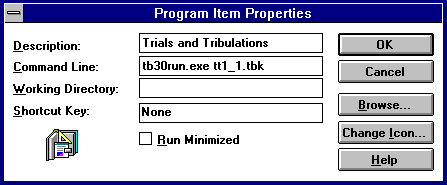
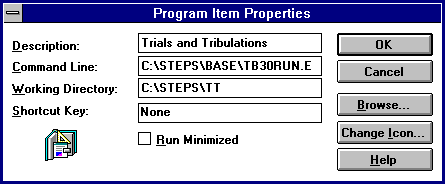
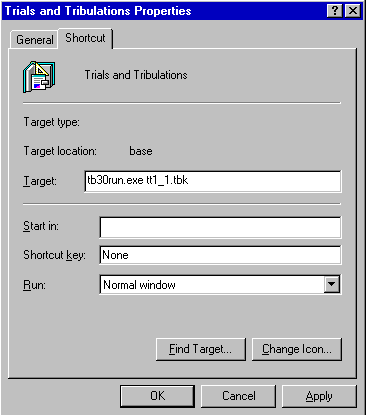
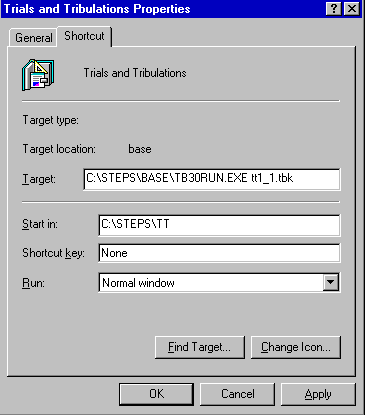
| I have installed the STEPS Base and then downloaded a module. When I run the module Setup program, it just installs the Base again and not the module. What am I doing wrong? |  |
You should delete all the temporary installation and setup files from your temporary directory after installing the STEPS Base, before trying to download a module (and also after installing one module before downloading the next). This is because if you unzip a module installation archive, over the Base archive, some of the existing files from the Base installation are not overwritten by the ones of the same name belonging to the module. This particularly applies to setup.exe, and means that the Setup program tries to install the Base again.
The same confusion happens if you unzip one module archive over another. The solution is to ensure that the temporary directory is emptied after installing one item before downloading the next one.
| The installer has not created icons for the modules that I have installed. How do I create them? |   |
This problem is generally confined to Windows 95.
This will create a shortcut to the module in your steps.grp file. You will need to modify this shortcut to include a Working Directory for the module. Do this as follows:

 Run-time Problems
Run-time Problems| I have installed the STEPS Base and a module, but when I click on the module icon, I get a message saying that tb30run.exe cannot be found. What is the problem? |  |
Windows does not know where the executable file tb30run.exe has been installed. There are a number of possible causes:
An error like this can mean that you already have a version of Toolbook on your system (which is then being wrongly picked up as the program to launch these STEPS modules), or that you have installed the modules in some non-standard way. Either way, the problem is easily rectified.
The STEPS Base includes all the programs (executables) you need to run any STEPS modules, and the solution is simply to ensure that your module is launched using the relevant executable from the STEPS Base directory. In the case of the three modules named above, that means using tbook.exe (rather than for example tb30run.exe which is used by most of the other STEPS modules).
Note that if you do have another version of Toolbook on your system, there is no need to uninstall it - it is not a problem.
For full instructions on how to ensure the correct Toolbook executable is used (by altering the Properties), see the answer to the question "When the STEPS Base is installed, it wants to alter my autoexec.bat file. Is this necessary or is there a way to avoid it?"
| I have installed the STEPS Base and a module on my PC, but when I run the module, I get occasional problems with icons and subscripts misplaced, and some text cut off. What is the problem? |   |
There are two types of screen driver. There are the ones supplied with Windows which come in a variety of resolutions and are the same on all machines. There are also the ones supplied by specific monitor or video card manufacturers.
The STEPS modules have been tested with standard Windows screen drivers (VGA and SVGA) and there have never been any problems with them. However with 'go faster' screen drivers supplied with particular machines, there have been occasional problems. The solution is to use the standard Windows screen driver for the resolution required and not a proprietry one. It may be necessary to alter the selected font and/or resolution, depending on graphic card or local configuration. With most modern video cards and associated screen drivers this can be done 'on the fly' without restarting the machine. This can be quite a technical issue, and you may wish to consult a local systems manager if you are experiencing difficulty with this; they may be able to automate the process, e.g. by creating an icon to reconfigure the set-up appropriately.
 General
General| Is there any documentation to accompany the modules? |  |
Yes: when you install a module, if you look at the files that are created you will find some Word documents in the directory. These consist of Students' Notes and Tutor's Notes for the particular module, and in some cases a student questionnaire, and are designed to be used in conjunction with the software. The files are supplied as Word documents (2.0 for Windows and 5.0 for Mac) so that you can customise them for your own use; however, please acknowledge the source and observe the copyright notice.
| Do I need any additional software to run the STEPS modules? |  |
Two of the Business modules, "Bank Account Blues" and "Probability Models" require Minitab version 6 or 8 to be present. No other modules require any additional software. On a PC, the only item that needs to be installed before you can install any STEPS modules is the STEPS Base. The lone Mac module available is a self-contained Hypercard application.
| My Web connection is very slow for downloading the software. Is it available by other means? |  |
The software is also available directly by ftp. If that is not a realistic option either, the modules can be purchased on disk.
| The Web site says the STEPS software is free to academic institutions. Can private individuals or commercial companies obtain the software? |  |
The STEPS software is available for purchase on disk. Alternatively, contact CTI Statistics at ctistat@gla.ac.uk stating your position, and it may be possible to negotiate a mutually agreeable fee for downloading the software.